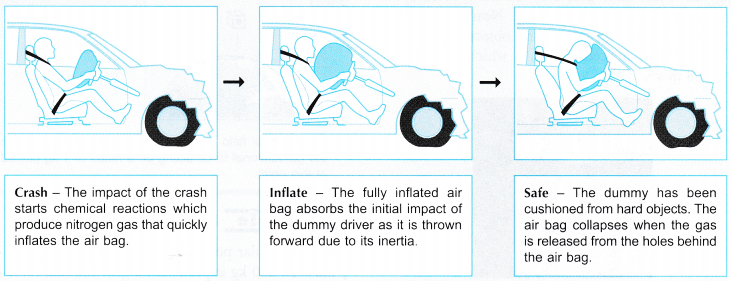Being Aware of the Need for Safety Features in Vehicles
While striving to improve the performance of their cars, car manufacturers also place great importance on the safety features of the cars. A good car safety system that can prevent injuries to passengers in the event of an accident is of utmost importance.
To protect passengers from harm in a car crash, the car must be able to absorb as much force from the impact as possible. Figure shows the features in a car that can improve its safety standard.

- Safety glass
The windscreen glass is specially designed to fracture into small rounded pieces upon impact instead of shattering so that the passengers will not be cut by the pieces that easily. - Passenger safety cell
The passenger safety cell is a strong rigid steel cage that will prevent the roof from collapsing on the passengers in the event that the car overturns. The passengers will be protected from direct impact of external forces. - Air bags
Air bags are hidden inside the steering wheel and dashboard of a car. They inflate within one hundredth second upon impact to cushion passengers from direct impact with the steering wheel, dashboard or the windscreen of the car. For effective protection by the air bags, the passengers must also be wearing safety belts at the same time. - Rear crumple zone
Designed to crumple upon impact. The increase in the impact time will reduce the impulsive force acting on the car. - Safety belts
The inertia-reel safety belts lock to keep wearers tightly held to their seats when a car decelerates rapidly. The passengers are prevented from being thrown forward due to their inertia. - Side-impact bar
Strong metal bars inside the door frame provide passengers with extra protection in the event of a side impact. - Front crumple zone
The front crumple zone is designed to crumple upon impact. The increase in the impact time will reduce the impulsive force acting on the car. - Anti-lock braking system (ABS)
The anti-lock braking system consists of a computerised system that rapidly holds and releases the brake alternately. It prevents the wheels from locking when the brake is applied and held by the driver. This prevents the car from skidding.

Each newly designed car must be tested for its safety features before it can be marketed. Figure shows a crash test done by a car manufacturer.
